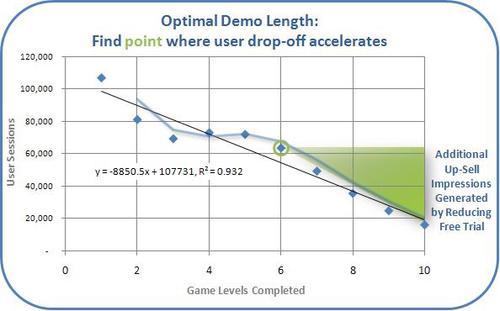An age-old question in any demo or trial program is how much of the product to give away in order to maximize sales. With Free and Paid sections, Apple has designed the iPhone App Store to easily facilitate this classic go-to-market strategy, and we’ve found that iPhone App free trial strategies are effective.
In the world of mobile applications, the question of how much to give away is actually a relatively new challenge since carriers, for the most part, did not support free trials on their decks. Previously, mobile developers dealt with the occasional issue of defining trial length only when they won a coveted embed (aka pre-load) deal on an OEM’s handset. With so many new developers throwing their hat into the iPhone App Store ring, there is little collective experience around this topic. Additionally, mobile application analytics solutions, like Flurry Analytics, did not exist. With Flurry Analytics, the guess work can be completely removed and developers can measure with precision the optimal up-sell point in their trial application.
Before we review mobile developers’ choices around “free” iPhone App store offerings, we want to point out that Apple requires the amount of a free game or app to be a full, stand-alone experience. For example, developers cannot “gray out” menu items that would appear in the paid application if the consumer were to purchase it. Additionally, since it’s well documented that few ad supported applications generate meaningful revenue, exceptions notwithstanding, we’ll suspend this topic for this blog post.
The decision of how much of a free game or application experience to give away begins with understanding the mechanics of the basic equation: Revenue = (Number of Free Players) x (Free to Paid Conversion %) x (Price per Unit). If a developer gives away too much of an experience, it inadvertently satisfies the consumer so that upgrading to the paid version does not seem necessary. However, by giving away a lot of value, the application may become more popular as a result, garnering strong community review scores and increasing the free version installed base. Having a large installed base means that a smaller percentage conversion is needed to make good money. Generally, we recommend a balance with a focus on optimizing conversion.
In other words, we recommend giving enough of the game or application away so the consumer understands the value, but still understands that if they buy the full version, there is a lot more value to be had. Overall, don’t be afraid to cut off a consumer if he isn’t willing to pay. We subscribe to the philosophy that developers should be focused on finding consumers who are willing to pay, not trying to completely satisfy free-rider consumers.
Below is an example of how one game developer tracked user progression in its free trial game. While this free version shipped with ten levels, analytics showed that most users failed to progress beyond level five of the free game. With the up-sell message shown at the end of the demo, describing additional features the consumer would get when purchasing the full version, many consumers did not see this. By cutting the free version in half, holding the same conversion rate, we estimate this developer could increase its sales by approximately 40%.

Traditionally, the process of deciding how much of a game or application to give away has been more art than science. While the length of a demo experience should vary from app to app, leveraging analytics data allows developers to test, track and tune their free trial strategy to drive maximum conversion rates and revenue.